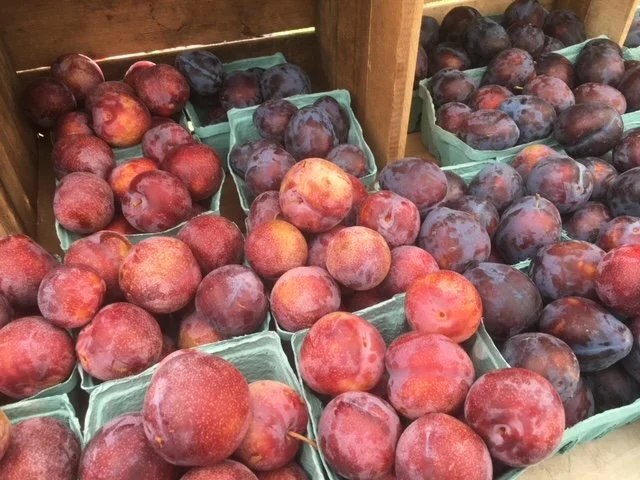Plum Perfect
Nothing beats a ripe plum. We’ve come to expect the standardized flavors, colors and textures of most fruits, but plums are wildcards with an assortment of sizes, shapes, and provenance. Most of us have had the misfortune to encounter the tasteless blobs of black and red plums ubiquitous to grocery stores shelves. Much like the Flavr Savr tomatoes, big agri-orchards tinkered with the genetics for shipping and longevity while ignoring the taste and lore of the fruits.
Most of the foods we eat today don’t look anything like the early cultivars, let alone had existed in antiquity. However, plums are one of the first fruits to have been domesticated. As far back as the Neolithic age there is archaeologic evidence of plums being cultivated specifically around human settlements in the Eastern Europe, the Caucus Mountains, and China before early trade routes carried them to Britain and Spain. Other academics and researchers believe their cultivation to have begun even earlier in Iran.
Plum tree cultivation was extensively documented in the 12th century Book on Agriculture written in Andalusia, meticulously recorded by medieval monks throughout Europe and shows up in classic literature, including works by Chaucer. By the 17th and 18th centuries, plums were all the rage as orchardists tinkered with new varieties. Many of these new varieties made their way to America with early settlers wanting to grow familiar crops of their homelands.
But why plums?
Most consumers today have never seen a plum tree. Old World varieties can grow up to 20 feet in height with a span of 30 feet which produce copious amounts of fruits. And what does one learn to do with such an abundance? Find a way to store it, of course.
One of the earliest methods for storing fruit was to dry it. Enter prunes. {yes, prunes are nothing more than dried plums}
Not all varieties of plums are suitable for drying. Like peaches, there are cling and freestone meaning either the flesh separates easily from the stone or it does not. Plums destined for drying need to be freestone with a high concentration of soluble solids and that won’t ferment during the drying process. Now you can see why orchardists of yore fiddled with breeding plums who filled all the requirement for successful drying and storage.
But what to do with all the cling varieties. Make wine, of course! The Balkans are renown for plum brandy known as slivovitz and in Romania over 80% of their plum crop is used for Țuică.
As much as plums stand up to drying, cooking, and fermenting I can’t tell you when I last saw plum jelly, plum wine, or prunes offered for sale or on a menu. Some of today’s adventurous cider makers are turning to old trees found in their hedgerows and using their unique characteristics in their craft. Prunes, having been given a less than stellar stereotype have been rebranded as dried plums. And the irony of ironies, plum pudding contains no plums.
But cruise through the orchard stands at the markets today and you’re going to find an assorted abundance of plums. Some are firm, almost crunchy like an apple, others are soft and almost gooey when perfectly ripe. My favorites are the big purple Italian plums which I bake into a plum torte when they come into season. Others I cook down until the flesh deflates from the skins and the pits slip free. Either break out the food mill or you can easily fish out the pits and skins with your fingers once everything has cooled. With a bit of added lemon juice or brandy the cooked plum pulp lasts for months in the refrigerator and can be used for both sweet and savory cooking. A dollop of plum and a pat of melted butter mixed with fresh herbs is an instant glaze or drizzle it over a scoop of vanilla ice cream for dessert.
Whatever you decide to do, do it soon because like everything at the farmers market they’re seasonal.

